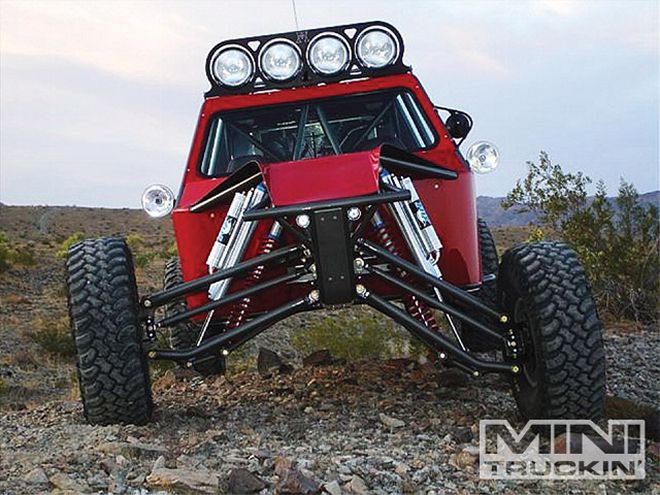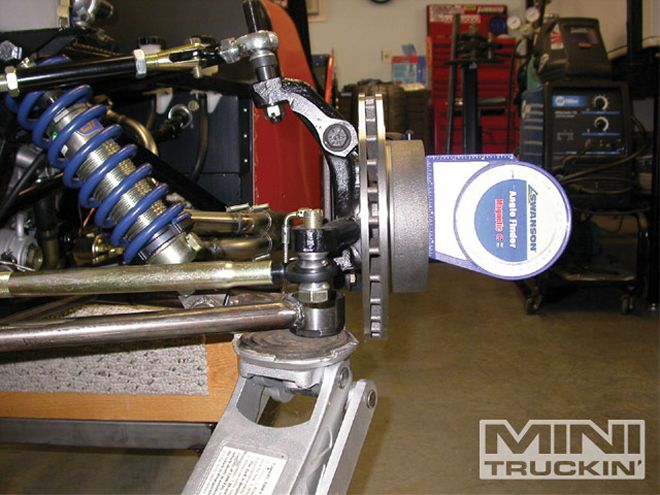
| This is a perfect example of how a suspension that was designed with no camber gain can have less than desirable traction, caused by the tire being forced to ride on its outer edge.
Why do vehicles have camber? Wouldn't it make more sense for the wheels to travel up and down without leaning in or moving all over the place?
There is a lot more going on in the front suspension of your truck than you would think, but for now we will focus on camber and why vehicle manufacturers have continued designing camber, into their vehicle's suspension. Camber is caused by a combination of the unequal length of the upper and lower A-arms, and the fact that the ball joints are further apart than the mounting points on the frame, thus creating an instant center. This arrangement of geometry can be changed to create more or less camber gain to yield a particular outcome. For instance, a performance car would benefit more from additional camber than a Cadillac would, wider cars would need less camber than narrow vehicles, and heavy cars would like more camber than light cars. Why, isn't important right now, just understand that camber comes in more than one size.
So, why camber then? When a vehicle enters a corner, centrifugal force is trying to push the vehicle off of the road, while the tires are trying desperately to keep the vehicle going in the direction that they are pointed. This struggle causes a few different things to happen; the most obvious is that the vehicle leans to the outside of the corner. Initially that would seem harmless enough, but understand that the wheels are directly attached to the chassis via the A-arms, and the A-arms are being pulled to the same angle as the chassis. This angle that the tires are being forced to follow is not good for traction, and cornering speed will suffer accordingly. Now, if you were to design a suspension that generated camber during cornering, the angle of the leaning chassis would be offset by the camber, allowing the tires to do their job efficiently, thus raising the performance capability of the vehicle.

| Camber is important for all vehicles and should be heavily researched and considered when building your suspension from scratch!
Now you might ask why you wouldn't just use a giant sway bar on the vehicle to keep it from leaning while cornering, and as a result, negating the need for camber. Well, I'll tell you why, because sway bars do not add traction, they take it (leave this one for another article). But just for argument's sake, let's assume that we have a vehicle that will not lean in a corner, would we still want camber then? Yes, a small amount of camber is almost always helpful. By dialing-in a 1/2-degree of camber (or so), you will help keep the contact patch of the tire flat to the road when cornering without sacrificing tread life.
Quite often I hear the comment "minitrucks aren't for handling anyway." This might be true, but do you think that you can drive across town without turning? Camber is for more than just cornering. Take note that Cadillacs, 2WD Suburbans, and many other lumbering vehicles aren't designed for handling, and they all have camber. Camber is one of those small things that just shouldn't be ignored. So do your homework and plan ahead, you will be glad you did.
To Submit A question, E-mail: mini.truckin@sourceinterlink.com
 | This is a perfect example of how a suspension that was designed with no camber gain can have less than desirable traction, caused by the tire being forced to ride on its outer edge.
Why do vehicles have camber? Wouldn't it make more sense for the wheels to travel up and down without leaning in or moving all over the place?
There is a lot more going on in the front suspension of your truck than you would think, but for now we will focus on camber and why vehicle manufacturers have continued designing camber, into their vehicle's suspension. Camber is caused by a combination of the unequal length of the upper and lower A-arms, and the fact that the ball joints are further apart than the mounting points on the frame, thus creating an instant center. This arrangement of geometry can be changed to create more or less camber gain to yield a particular outcome. For instance, a performance car would benefit more from additional camber than a Cadillac would, wider cars would need less camber than narrow vehicles, and heavy cars would like more camber than light cars. Why, isn't important right now, just understand that camber comes in more than one size.
So, why camber then? When a vehicle enters a corner, centrifugal force is trying to push the vehicle off of the road, while the tires are trying desperately to keep the vehicle going in the direction that they are pointed. This struggle causes a few different things to happen; the most obvious is that the vehicle leans to the outside of the corner. Initially that would seem harmless enough, but understand that the wheels are directly attached to the chassis via the A-arms, and the A-arms are being pulled to the same angle as the chassis. This angle that the tires are being forced to follow is not good for traction, and cornering speed will suffer accordingly. Now, if you were to design a suspension that generated camber during cornering, the angle of the leaning chassis would be offset by the camber, allowing the tires to do their job efficiently, thus raising the performance capability of the vehicle.
| This is a perfect example of how a suspension that was designed with no camber gain can have less than desirable traction, caused by the tire being forced to ride on its outer edge.
Why do vehicles have camber? Wouldn't it make more sense for the wheels to travel up and down without leaning in or moving all over the place?
There is a lot more going on in the front suspension of your truck than you would think, but for now we will focus on camber and why vehicle manufacturers have continued designing camber, into their vehicle's suspension. Camber is caused by a combination of the unequal length of the upper and lower A-arms, and the fact that the ball joints are further apart than the mounting points on the frame, thus creating an instant center. This arrangement of geometry can be changed to create more or less camber gain to yield a particular outcome. For instance, a performance car would benefit more from additional camber than a Cadillac would, wider cars would need less camber than narrow vehicles, and heavy cars would like more camber than light cars. Why, isn't important right now, just understand that camber comes in more than one size.
So, why camber then? When a vehicle enters a corner, centrifugal force is trying to push the vehicle off of the road, while the tires are trying desperately to keep the vehicle going in the direction that they are pointed. This struggle causes a few different things to happen; the most obvious is that the vehicle leans to the outside of the corner. Initially that would seem harmless enough, but understand that the wheels are directly attached to the chassis via the A-arms, and the A-arms are being pulled to the same angle as the chassis. This angle that the tires are being forced to follow is not good for traction, and cornering speed will suffer accordingly. Now, if you were to design a suspension that generated camber during cornering, the angle of the leaning chassis would be offset by the camber, allowing the tires to do their job efficiently, thus raising the performance capability of the vehicle.
 | Camber is important for all vehicles and should be heavily researched and considered when building your suspension from scratch!
Now you might ask why you wouldn't just use a giant sway bar on the vehicle to keep it from leaning while cornering, and as a result, negating the need for camber. Well, I'll tell you why, because sway bars do not add traction, they take it (leave this one for another article). But just for argument's sake, let's assume that we have a vehicle that will not lean in a corner, would we still want camber then? Yes, a small amount of camber is almost always helpful. By dialing-in a 1/2-degree of camber (or so), you will help keep the contact patch of the tire flat to the road when cornering without sacrificing tread life.
Quite often I hear the comment "minitrucks aren't for handling anyway." This might be true, but do you think that you can drive across town without turning? Camber is for more than just cornering. Take note that Cadillacs, 2WD Suburbans, and many other lumbering vehicles aren't designed for handling, and they all have camber. Camber is one of those small things that just shouldn't be ignored. So do your homework and plan ahead, you will be glad you did.
To Submit A question, E-mail: mini.truckin@sourceinterlink.com
| Camber is important for all vehicles and should be heavily researched and considered when building your suspension from scratch!
Now you might ask why you wouldn't just use a giant sway bar on the vehicle to keep it from leaning while cornering, and as a result, negating the need for camber. Well, I'll tell you why, because sway bars do not add traction, they take it (leave this one for another article). But just for argument's sake, let's assume that we have a vehicle that will not lean in a corner, would we still want camber then? Yes, a small amount of camber is almost always helpful. By dialing-in a 1/2-degree of camber (or so), you will help keep the contact patch of the tire flat to the road when cornering without sacrificing tread life.
Quite often I hear the comment "minitrucks aren't for handling anyway." This might be true, but do you think that you can drive across town without turning? Camber is for more than just cornering. Take note that Cadillacs, 2WD Suburbans, and many other lumbering vehicles aren't designed for handling, and they all have camber. Camber is one of those small things that just shouldn't be ignored. So do your homework and plan ahead, you will be glad you did.
To Submit A question, E-mail: mini.truckin@sourceinterlink.com